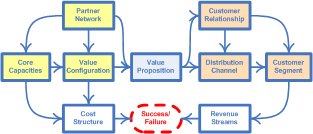Business Models

Alex Osterwalder and I have been exchanging e-mails on the subject of business models. Alex's blog is devoted entirely to this subject, and the graphic above is his 'business model model', showing the nine 'building blocks' for such models from his synthesis of reading on the subject. The right side of the model is about how the business generates revenue, while the left side is about how it manages costs and hence generates profit. I've been advising clients and prospective new businesses how to document and evaluate their business model for years, and in my experience there are three types of business models, that organizations look at in sequence:
Viability Model: How the idea/project/plan/business will make money, and with which partners. In some cases it is actually about How the idea/project/plan/business will fill an untapped need, and with which partners. Such a model outlines the research that will be done to ensure the value proposition is compelling (i.e. customers want and are prepared to pay for it), that the business has, or can acquire, the competencies and resources needed to deliver it, and that it makes strategic sense for the organization (e.g. it's consistent with their mission and values and does not cannibalize existing business). This model culminates in a go/no go decision.
Formation Model: How the idea/project/plan/business will be set up. This model is focused on capital and infrastructure that must be in place before operations can begin: human capital (what people will be involved in what roles), intellectual capital (what knowledge, technology and know-how must be put in place), physical capital (what premises, equipment and supplies will be needed prior to start-up), financial capital (start-up money, and where it will come from), and social capital (organization, alliances and relationships that will drive it). This model culminates in a launch.
Operating Model: How the idea/project/plan/business will operate. This model describes the ongoing activities of the organization or project -- what megaprocesses it will entail (e.g. R&D, purchasing, sales & marketing, manufacturing, distribution, service, back office support, and management decision making), what budgets and other resources it will require and use, and what roles will be played by who.

0 Comments:
Post a Comment
<< Home